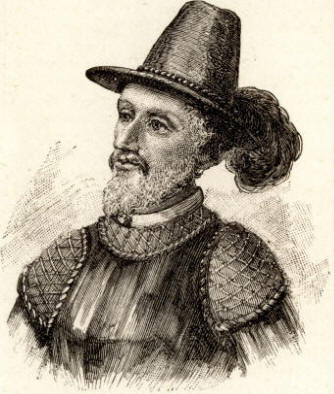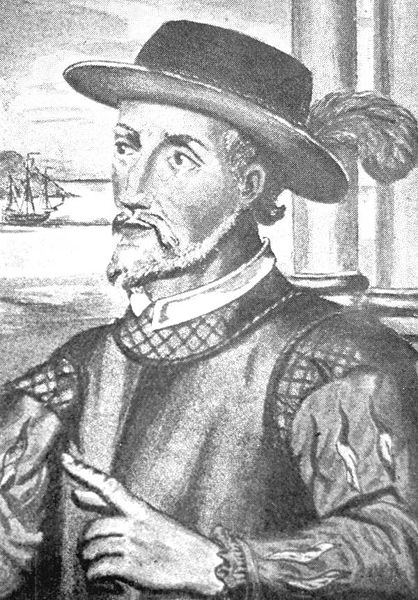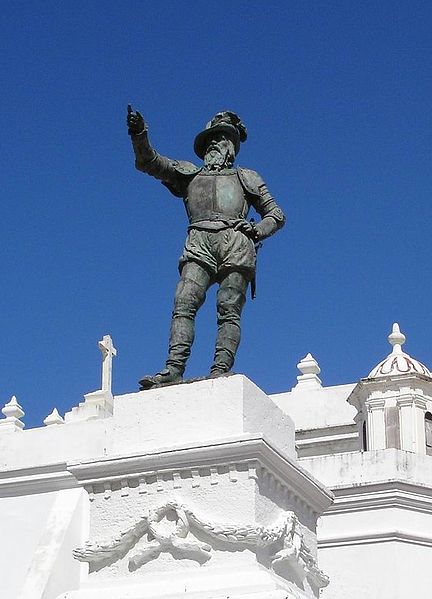<Back to Index>
- Economist Vilfredo Federico Damaso Pareto, 1848
- Painter Rembrandt Harmenszoon van Rijn, 1606
- Explorer and Governor of Puerto Rico Juan Ponce de León y Figueroa, 1474



Juan Ponce de León y Figueroa, (1474 – July 1521) was a Spanish explorer. He became the first Governor of Puerto Rico by appointment of the Spanish Crown. He led the first European expedition to Florida, which he named. He is associated with the legend of the Fountain of Youth, reputed to be in Florida.
Juan Ponce de León was born in the village of Santervás de Campos in the northern part of what is now the Spanish province of Valladolid. Although early historians placed his birth in 1460, more recent
evidence shows he was likely born in 1474. His family genealogy is
extremely confusing and poorly documented. There is no consensus on who
his parents were but it seems that he was a member of a distinguished
and influential noble family. His relatives included Rodrigo Ponce de
León, the Marquess of Cádiz and a celebrated figure in the Moorish wars. Ponce
de León was also related to another notable family,
Núñez de Guzmán, and as a young man he served as
squire to Pedro Núñez de Guzmán, Knight Commander
of the Order of Calatrava. A contemporary chronicler, Gonzalo Fernandez de Oviedo y Valdes, states that Ponce de León became an experienced soldier fighting in the Spanish campaigns that defeated the Moors in Granada and completed the re-conquest of Spain in 1492. When the war against the Emirate of Granada ended,
there was no apparent need for his military services at home and like
many of his contemporaries, Ponce de León looked abroad for his
next opportunity. In September 1493, some 1200 sailors, colonists, and soldiers joined Christopher Columbus for his second voyage to the New World. Ponce de León was a member of this expedition, one of 200 “gentleman volunteers.” The fleet reached the Caribbean in November 1493, and visited several islands before arriving at their primary destination in Hispaniola. In particular they anchored on the coast of a large island the natives called Boriquen but would eventually become known as Puerto Rico. This was Ponce de León’s first glimpse of the place that would play a major role in his future. From
here there is no trace of Ponce de León’s activities for the
next several years. Historians are divided on what he did during this
time, but it is possible that he returned to Spain at some point and
made his way back to Hispaniola with Nicolás de Ovando. In 1502 the newly appointed governor, Nicolás de Ovando, arrived in Hispaniola.
His directive from the Spanish Crown was to bring order to a colony in
disarray. One of Ovando’s priorities was to complete the subjugation of
the native Taínos. In 1504, when a small Spanish garrison was overrun by the Taínos in Higüey on
the eastern side of the island, Ponce de León was assigned a
major role in crushing this rebellion. Ovando must have been impressed
with Ponce de León — he appointed him frontier governor of the new
province, Higüey. In addition, Ovando awarded him a substantial
land grant along with sufficient Indian labor to farm his new estate. Ponce de León prospered in this new role. He found a ready market for his farm produce and livestock at nearby Boca de Yuma where
Spanish ships made a final call for supplies before the long voyage
back to Spain. In 1505 he was authorized by Ovando to establish a new
town in Higüey, which he named Salvaleón. Around
this same time, Ponce de León married Leonora, the daughter of
an innkeeper. They had three daughters, Juana, Isabel and Maria; and
one son, Luis. He built a large stone house for his growing family — a
house that still stands today near the city of Salvaleón de
Higüey. As provincial governor, Ponce de León had occasion to meet with the Taínos who visited his province from the neighboring island of Boriquen.
They told him stories of a fertile land with much gold to be found in
the many rivers. Inspired by the possibility of riches, Ponce de
León requested and received permission from Ovando to explore the island. His
first reconnaissance of the island is usually dated 1508 but there is
evidence that he had made a previous exploration as early as 1506. This
earlier trip was done quietly because the Spanish Crown had commissioned Vicente Yáñez Pinzón to
settle the island in 1505. Pinzón did not fulfill his commission
and it expired in 1507, leaving the way clear for Ponce de León. His
earlier exploration had confirmed the presence of gold and gave him a
good understanding of the geography of the island. In 1508, Ferdinand II of Aragon gave permission to Ponce de León for the first official expedition
to the island, which the Spanish then called San Juan Bautista. This
expedition, consisting of about 50 men in one ship, left Hispaniola on
June 12, 1508 and eventually anchored in San Juan Bay, near today’s
city of San Juan. Ponce de León searched inland until he found a
suitable site about two miles from the bay. Here he erected a
storehouse and a fortified house, creating the first settlement in
Puerto Rico, Caparra. Although a few crops were planted, they spent most of their time and energy searching for gold.
By early 1509 Ponce de León decided to return to Hispaniola.
They had collected a good quantity of the precious metal but were
running low on food and supplies. The
expedition was deemed a great success and Ovando appointed Ponce de
León governor of San Juan Bautista. This appointment was later
confirmed by Ferdinand II on August 14, 1509. He was instructed to
extend the settlement of the island and continue mining for gold. The
new governor returned to the island as instructed, bringing with him
his wife and children. Back
on his island, Ponce de León parceled out the native
Taínos amongst himself and other settlers using a system of
forced labor known as encomienda. The Indians were put to work growing food crops and mining for gold. Many of the Spaniards treated the Taínos very harshly and newly introduced diseases like smallpox and measles took
a severe toll on the local population. By June 1511 the Taínos
were pushed to a short-lived rebellion, which was forcibly put down by
Ponce de León and a small force of troops armed with crossbows and arquebuses. Even
as Ponce de León was settling the island of San Juan,
significant changes were taking place in the politics and government of
the Spanish West Indies. On July 10, 1509, Diego Colón, the son of Christopher Columbus, arrived in Hispaniola as acting Viceroy, replacing Nicolás de Ovando. For
several years Diego Colón had been waging a legal battle over
his rights to inherit the titles and privileges granted to his father.
The Crown regretted the sweeping powers that had been granted to
Columbus and his heirs and sought to establish more direct control in
the New World. In spite of the Crown’s opposition, Colón
prevailed in court and Ferdinand was required to appoint him Viceroy. Although
the courts had ordered that Ponce de León should remain in
office, Colón circumvented this directive on October 28, 1509 by
appointing Juan Ceron chief justice and Miguel Diaz chief constable of
the island, effectively overriding the authority of the governor. This
situation prevailed until March 2, 1510 when Ferdinand issued orders
reaffirming Ponce de León’s position as governor. Ponce de
León then had Ceron and Diaz arrested and sent back to Spain. The
political struggle between Colón and Ponce de León
continued in this manner for the next few years. Ponce de León
had influential supporters in Spain and Ferdinand regarded him as a
loyal servant. However, Colón's position as Viceroy made him a
powerful opponent and eventually it became clear that Ponce de
León's position on San Juan was not tenable. Finally, on November 28, 1511, Ceron returned from Spain and was officially re-instated as governor. Rumors of undiscovered islands to the northwest of Hispaniola had reached Spain by 1511 and Ferdinand was
interested in forestalling further exploration and discovery by
Colón. In an effort to reward Ponce de León for his
services, Ferdinand urged him to seek these new lands outside the
authority of Colón. Ponce de León readily agreed to a new
venture and in February 1512 a royal contract was dispatched outlining
his rights and authorities to search for "the Islands of Benimy". The
contract stipulated that Ponce de León held exclusive rights to
the discovery of Benimy and neighboring islands for the next three
years. He would be governor for life of any lands he discovered but he
was expected to finance for himself all costs of exploration and
settlement. In addition, the contract gave specific instructions for
the distribution of gold, Native Americans, and other profits extracted
from the new lands. Notably, there was no mention of a rejuvenating
fountain. Ponce
de León equipped three ships with at least 200 men at his own
expense and set out from Puerto Rico on March 4, 1513. The only
contemporary description known for this expedition comes from Antonio de Herrera y Tordesillas,
a Spanish historian who apparently had access to the original ships'
logs or related secondary sources from which he created a summary of
the voyage published in 1601. The
brevity of the account and occasional gaps in the record have led
historians to speculate and dispute many details of the voyage. The three ships in this small fleet were the Santiago, the San Cristobal and the Santa Maria de la Consolacion.
Anton de Alaminos was their chief pilot. He was already an experienced
sailor and would become one of the most respected pilots in the region.
After leaving Puerto Rico, they sailed northwest along the great chain
of Bahama Islands, known then as the Lucayos. By March 27, Easter
Sunday, they reached the northern end of the Bahamas sighting an unfamiliar island (probably Great Abaco). For
the next several days the fleet crossed open water until April 2, 1513,
when they sighted land which Ponce de León believed was another island. He named it La Florida in recognition of the verdant landscape and because it was the Easter season, which the Spaniards called Pascua Florida (Festival of Flowers). The following day they came ashore to seek information and take possession of this new land. The
precise location of their landing on the Florida coast has been
disputed for many years. Some historians believe it occurred at St. Augustine; others prefer a more southern landing at a small harbor now called Ponce de León Inlet; and some argue that Ponce came ashore even further south near the present location of Melbourne Beach. After
remaining in the vicinity of their first landing for about five days,
the ships turned south for further exploration of the coast. On April 8
they encountered a current so strong that it pushed them backwards and
forced them to seek anchorage. The tiniest ship, the San Cristobal, was carried out of sight and lost for two days. This was the first encounter with the Gulf Stream where
it reaches maximum force between the Florida coast and the Bahamas.
Because of the powerful boost provided by the current, it would soon
become the primary route for eastbound ships leaving the Spanish Indies
bound for Europe. They continued down the coast hugging the shore to avoid the strong head current. By May 4 the fleet reached Biscayne Bay and took on water at an island they named Santa Marta (now Key Biscayne). On May 15 they were coasting along the Florida Keys,
looking for a passage to head north and explore the west coast of the
Florida peninsula. From a distance the Keys reminded Ponce de
León of men who were suffering, so he named them Los Martires (the Martyrs). Eventually
they found a gap in the reefs and sailed "to the north and other times
to the northeast" until they reached the Florida mainland on May 23. Again, the exact site of their landfall is controversial. The vicinity of Charlotte Harbor is the most commonly identified spot while some assert a landing further north at Tampa Bay or even Pensacola. Other historians have argued the distances were too great to cover in the available time and the more likely location was Cape Romano or Cape Sable. Here Ponce de León anchored for several days to take on water and repair the ships. They were approached by Native Americans who
were initially interested in trading but relations soon turned hostile.
Several skirmishes followed with casualties on both sides and the
Spaniards took eight Indians captive. On
June 14 they set sail again looking for a chain of islands in the west
that had been described by their captives. They reached the Dry Tortugas on June 21. There they captured giant sea turtles, Caribbean Monk Seals, and thousands of seabirds.
From these islands they sailed southwest in an apparent attempt to
circle around Cuba and return home to Puerto Rico. Failing to take into
account the powerful currents pushing them eastward, they struck the
northeast shore of Cuba and were initially confused about their
location. Once
they regained their bearings, the fleet retraced their route east along
the Florida Keys and around the Florida peninsula, reaching Grand Bahama on July 8. They were surprised to come across another Spanish ship, piloted by Diego Miruelo, who was either on a slaving voyage or had been sent by Diego Colón to
spy on Ponce de León. Shortly thereafter Miruelo's ship was
wrecked in a storm and Ponce de León rescued the stranded crew.
From here the little fleet disbanded. Ponce de León tasked the Santa Maria with
further exploration while he returned home with the rest of crew. Ponce
de León reached Puerto Rico on October 19 after having been away
for almost eight months. The other ship, after further explorations
returned safely on February 20, 1514. Upon his return to Puerto Rico, Ponce de León found the island in turmoil. A party of Caribs from a neighboring island had attacked the settlement of Caparra,
killed several Spaniards and burned it to the ground. Ponce de
León's own home was destroyed and his family narrowly escaped. Colón used the attack as a pretext for renewing hostilities against the local Taíno tribes.
The explorer suspected that Colón was working to further
undermine his position on the island and perhaps even to take his
claims for the newly discovered Florida. Ponce
de León decided he should return to Spain and personally report
the results of his recent expedition. He left Puerto Rico in April 1514
and was warmly received by Ferdinand when he arrived at court in Valladolid. There he was knighted and given a personal coat of arms - the first conquistador to receive these honors. He also visited Casa de Contratación in Seville,
which was the central bureaucracy and clearinghouse for all of Spain's
activities in the New World. The Casa took detailed notes of his
discoveries and added them to the Padrón Real, a master map which served as the basis for official navigation charts provided to Spanish captains and pilots. During his stay in Spain, a new contract was drawn up for Ponce de León confirming his rights to settle and govern the "islands" of Florida and Bimini.
In addition to the usual directions for sharing gold and other
valuables with the king, the contract was one of the first to stipulate
that the Requerimiento was
to be read to the inhabitants of the islands prior to their conquest.
Ponce de León was also ordered to organize an armada for the
purpose of attacking and subduing the Caribs, who continued to attack
Spanish settlements in the Caribbean. Three
ships were purchased for his armada and after repairs and provisioning
Ponce de León left Spain on May 14, 1515 with his little fleet.
The record of his activities against the Caribs is vague. There was one
engagement in Guadeloupe on his return to Spain and possibly two or
three other encounters. The
campaign came to an abrupt end in 1516 when Ferdinand died. The king
had been a strong supporter and Ponce de León felt it was
imperative he return to Spain and defend his privileges and titles. He
did receive assurances of support from Cardinal Francisco Jiménez de Cisneros,
the regent appointed to govern Castile, but it was nearly two years
before he was able to return home to Puerto Rico. Meanwhile,
there had been at least two unauthorized voyages to "his" Florida, and
Ponce de Leon realized he had to act soon if he was to maintain his
claim. In
1521 Ponce de León organized a colonizing expedition on two
ships. It consisted of some 200 men, including priests, farmers and
artisans, 50 horses and other domestic animals, and farming implements.
The expedition landed on the southwest coast of Florida, in the
vicinity of Caloosahatchee River or Charlotte Harbor. The colonists were soon attacked by Calusa braves and Ponce de León was injured when an arrow poisoned with the sap of the Manchineel tree struck his shoulder. After this attack, he and the colonists sailed to Havana, Cuba, where he soon died of the wound. He was buried in the crypt of San José Church from 1559 to 1836, when his remains were exhumed and later transferred to the Cathedral of San Juan Bautista.